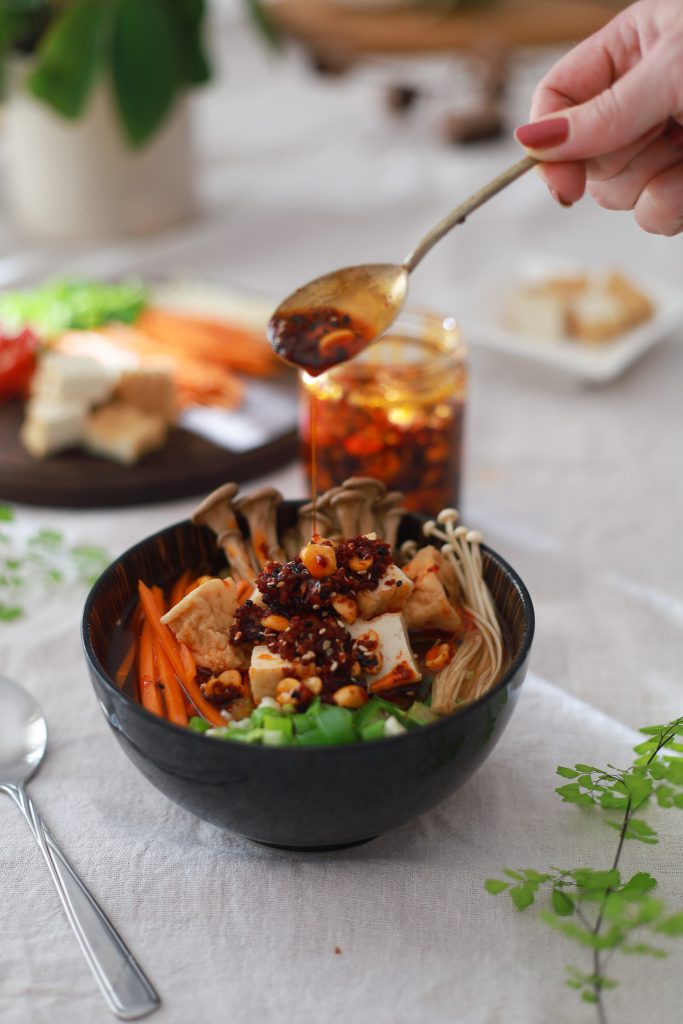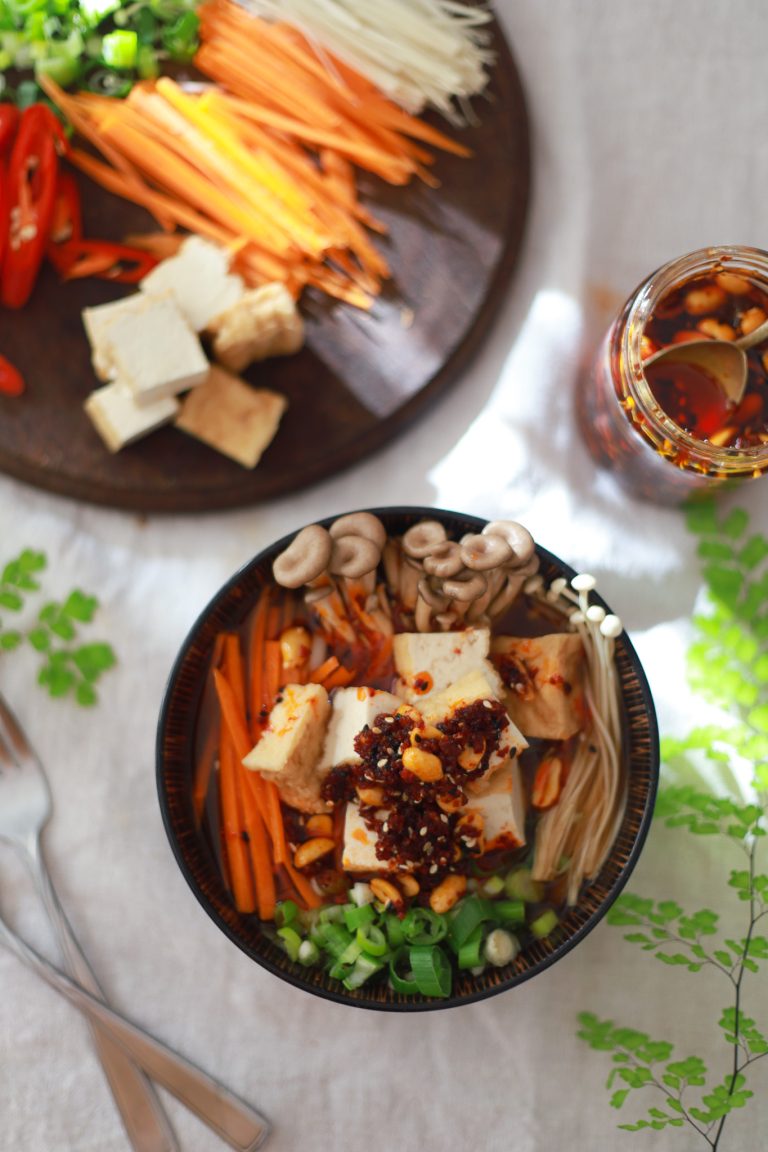There’s nothing more nourishing than a warm bowlful of noodles, packed full of spicy ginger and bursting with Asian flavours. But what’s the difference between a good ramen and an exceptional one? It’s the broth of course, and this recipe does not disappoint. This tofu ginger, miso ramen is totally customisable to your personal taste, but one thing you won’t want to skimp on is the miso… the deep rich umami flavour is what truly carries the dish, go hard or go home!
Preparing the dashi
Dashi is a type of soup stock that serves as the foundation for many traditional Japanese dishes, including miso soup, noodle soup, and other broth-based creations. The process of making dashi involves simmering dried kombu seaweed and dried bonito flakes in water. The ingredients are carefully selected and prepared, and the timing and temperature of the simmering process are crucial to achieving the best flavor. The resulting dashi is a clear, flavorful broth that is the backbone of many Japanese dishes.
History of Dashi
Dashi is a fundamental base to many Japanese dishes and has been an essential part of Japanese cuisine for centuries. Its history can be traced back to the Edo period when it was first used as a soup base. Over time, different regions and chefs developed their own variations of dashi, using different types of fish, seaweed, or mushrooms. Today, dashi is used not only in soups but also in sauces, stews, and other dishes, and is considered a cornerstone of Japanese cooking.
I always have dashi in my refridgerator, it’s the almight Japanese ingredient!
Masaharu Morimoto
Making a dashing dashi
Whether you make your dashi with traditional Japanese methods or make a few modifications to create it to your own taste, it’s without a doubt the base that will make or break your Ramen. Try adding different types of seafood like shrimp, crab or even anchovies! A diversity of mushrooms will also bring different qualities to the broth, and choosing to use them fresh or dried will also change the flavour again. You can also experiment with different ratios of ingredients to find the perfect balance of umami and even add a touch of sweetness. Additionally, incorporating herbs and spices like ginger or green onion can add a new dimension to your dashi. But however you flavour it, it’s destined to be a new favourite staple in your recipe repertoire just like making your own stock from scratch.
Also Read: The best chicken stock I’ve ever made (TBA)

Not all seaweed is right for your dashi…
The best types of seaweed for making dashi are typically high-quality kombu from Hokkaido or Rishiri Island. Ultimately, the type of seaweed used will depend on personal preference and availability.
- Ma-kombu and Rausu-kombu are two popular varieties known for their rich umami flavor.
- Wakame and nori can also be used to make dashi, but they are not as traditional or commonly used as kombu.
Of course, not everyone has access to proper Japanese seaweed and that’s also a long way for one ingredient to travel. There are of course equivalents much closer to home. In Australia, we have an abundant supply of our own kelps and you’ll often find them at most health food stores and artisan grocers.
A Note On Ingredients:
- Dried Kombu: (info as above) Look for this dried, eidble seaweed in an Asian super market or in the Asian food section of many large supermarkets.
- Water: Ideally use filtered or spring water.
- Katsobushi: Also called bonito flakes (simmered, smoked and fermented skipjack tuna that’s been dehydrated and turned into flakes that look a lot like fish flakes)
- Pork Broth: Ideally I would use homemade, but since that’s not always possible to make with everyday time constraints and also not easily found in shops, you can also substituted with chicken, mushroom or vegetable stock if needed.
- Chicken Broth: Ideally homemade, but in the absence of this there are now an abundance of premade fresh stocks available at most supermarkets. Of course, it’s always going to be preferable and more flavoursome to make your own though.
- Red Miso Paste / Brown Miso Paste: Abundantly available in all Asian supermarkets, the refrigerated section of your local health food store and often in the Asian section of most regular supermarkets. You can use powdered miso for this recipe, but I really don’t think it has the same depth of flavour as the fresh pastes, so try if you can to get the proper fresh stuff – it also has the added benefit that it is a fermented food, so the more alive the better the health properties.
- Ginger: It’s absolutely essential to use fresh ginger for this, sure add some powder for an extra boost if you please, but definitely don’t skimp on the fresh stuff, it gives a much deeper spice and warmth to the dish.
- Rayu: Is a traditional condiment of Japan that adds a complexity of flavour and an element of heat to any dish it graces with its presence. Find out more about it here.

Tofu, Ginger, Miso Ramen & Peanut Rayu
Ingredients
For the dashi
- 2 cups water
- 1 knob fresh ginger (sliced)
- 1/4 cup dried kombu
- 1/4 cup dried bonito flakes
- 4 cloves garlic (sliced)
For the ramen
- 1 cup pork broth (Also use mushroom broth.)
- 1 cup stock (vegetable or chicken)
- 1 tbsp red miso
- 1 tbsp brown miso
- 1 fresh carrot (cut into thin strips or jullienned)
- 1 block hard tofu (cut into cubes – pre-fried if you like)
- 4 whole spring onions
- 3 tbsp innoki mushrooms (fresh)
- 3 sliced shitake mushrooms (fresh)
- 1 tbsp sesame oil
- 1 tbsp soy sauce
- 250 grams ramen noodles
To serve
- 1 tbsp peanut rayu
Instructions
- Preparing the tofu: Either bake, fry or deep fry the tofu for 15 minutes, or until crispy on the outside and soft on the inside and heated through. Set aside.
- Preparing the egg: Bring a pot of water to the boil and add the fresh eggs to the water. Cook for 5 minutes. Take out of the pot and put aside until cool enough to peel.
- To make the dashi: Heat the water and add the kombu, bonito, ginger and garlic, boil for around 20 minutes or until the flavour is nicely infused.
- Strain the broth and put back on the stove, add the ginger back and then also add the stock, miso, carrots, mushrooms, sesame oil and soy sauce. Boil for another 15 minutes.
- Preparing the ramen: Add the ramen to the broth and let sit for 3 minutes, stirring occasionally. When the noodles are cooked, top with the tofu, cut open eggs, spring onions, sesame seeds and peanut rayu. Serve immediately.
Notes
Did you make this recipe?
Lovely. Now let me know how you liked it. Tag me @thetastyspoonful on Instagram or send us a message on Facebook @ The Tasty Spoonful
While I have you here, may I suggest you try these next:
Until next time. Keep following, liking, sharing, commenting and cooking, and may your every spoonful be tastier than the last!




